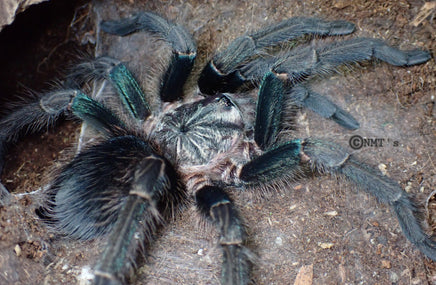
The Phormictopus sp. 'Full Green' is a breathtaking tarantula that commands attention with its striking metallic green sheen. This species is a must-have for enthusiasts who appreciate bold colors and impressive size. Known for its relatively fast growth and formidable appearance, the Phormictopus sp. 'Full Green' is a showstopper in any collection, appealing to both experienced keepers and those ready to explore the more vibrant species in the hobby.
Care Details:
- Temperature: Ideal range for most tarantulas is 75 to 85°F (24 to 29°C). Tarantulas in warmer environments eat more, grow faster, and molt quicker. This care flexibility makes tarantulas easy to maintain.
- Humidity: Maintain humidity at around 65-75%. Water dishes are not necessary, but if used, they pose no harm. I personally do not use them.
-
Housing:
- Terrestrial species: A 1 oz to 4 oz deli container with needle-made ventilation is perfect for babies. Free containers are available at checkout, but you must ask during checkout to receive one. For juveniles, an enclosure 2 to 3 times their size is recommended. Adults thrive in enclosures that offer both space and substrate for burrowing.
Diet:
I personally give them a variety of crickets and cockroaches, including Dubia, Red-runner, Lobster, and Madagascar hissing roaches. For the baby tarantulas, baby crickets and baby roaches are ideal. If you have access to only one type of prey, that is also perfectly fine.
If you cannot find a small enough cricket or cockroach, just crush its head and leave it in the enclosure; your tarantula should handle the rest. Remember to remove any uneaten food to prevent any mold growth. And for an occasional treat, a pinky or hopper mouse adds a nice variety to their diet. Make sure to not overfeed rodents and feeder lizards to your tarantulas, these should be done every once in a while as a treat. Too much calcium is not good for the tarantula as it can cause constipation and the tarantula might have a hard time pooping.
In-depth Facts:
- Latin name: Phormictopus sp. 'Full Green'
- Common name: No widely recognized common name; often referred to simply by its Latin name or as "Full Green."
- Locale: Native to the Caribbean, particularly the Dominican Republic.
- Category: Terrestrial, but known to climb occasionally. They are moderately active and do not web excessively.
- Size: Females can grow up to 9 inches, with males slightly smaller, reaching about 6-7 inches.
- Urticating hairs: Yes, it possesses urticating hairs.
- Growth rate: Fast grower, often reaching maturity quicker than many other species.
- Life span: Females can live up to 15-20 years, while males typically live 3-5 years.
- Recommended levels: Best suited for intermediate to advanced keepers due to their size, speed, and defensive nature.
Stay Connected:
- Instagram: Follow my Instagram, I'm most active here.
- YouTube: For care and education videos, check out my YouTube channel.
- Facebook: Over here I have all my reviews.
- TikTok: Visit my TikTok for additional content.
Safety Disclaimer:
Experiencing a tarantula bite is an extremely rare occurrence, and it's important to note that there have been no recorded fatalities due to a tarantula bite. The venom potency varies across species, with Old World tarantulas generally having stronger venom than their New World counterparts. Within the Old World category, the Poecilotheria genus is known for having particularly potent venom.
It's crucial to approach tarantulas with respect and understanding. If you happen to get bitten, which is unlikely, the key is to stay calm. In most cases, the discomfort is superficial and subsides within a few minutes to a few hours. However, bites from species with more potent venom may result in symptoms lasting up to a week. Remember, larger tarantulas tend to have more venom than smaller ones.
Please be aware that I cannot assume responsibility for bites. Tarantula handling should be done at your own risk. In my 11 years of experience with these creatures, I have only been bitten once, by a species with highly potent venom. While the experience was painful, the symptoms had completely disappeared after a week.
Handle tarantulas responsibly, and always prioritize your safety and the well-being of the tarantula.